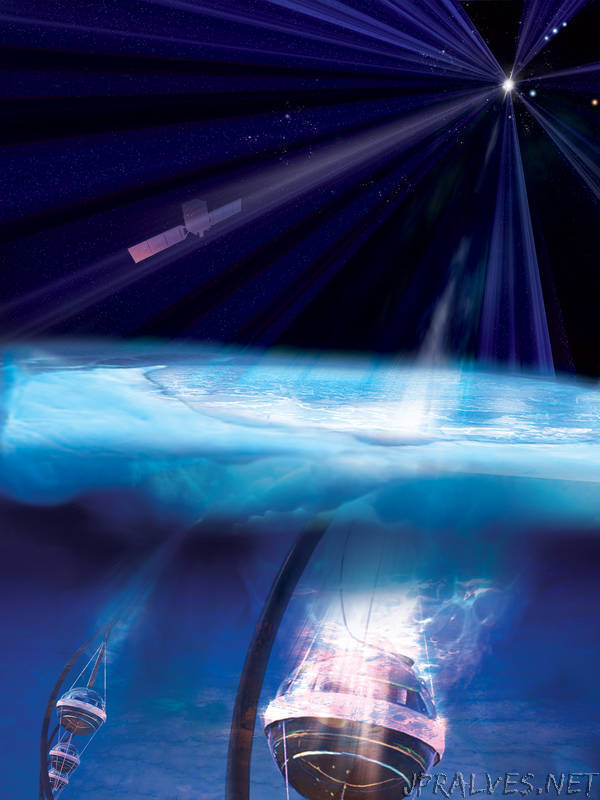
“For the first time ever, scientists using NASA’s Fermi Gamma-ray Space Telescope have found the source of a high-energy neutrino from outside our galaxy. This neutrino traveled 3.7 billion years at almost the speed of light before being detected on Earth. This is farther than any other neutrino whose origin scientists can identify.
High-energy neutrinos are hard-to-catch particles that scientists think are created by the most powerful events in the cosmos, such as galaxy mergers and material falling onto supermassive black holes. They travel at speeds just shy of the speed of light and rarely interact with other matter, allowing them to travel unimpeded across distances of billions of light-years.
Artist visual of a supermassive black hole in a distant galaxy
The discovery of a high-energy neutrino on September 22, 2017, sent astronomers on a chase to locate its source—a supermassive black hole in a distant galaxy.
Credits: NASA’s Goddard Space Flight Center
Video: NASA’s Fermi Links Cosmic Neutrino to Monster Black Hole
The neutrino was discovered by an international team of scientists using the National Science Foundation’s IceCube Neutrino Observatory at the Amundsen–Scott South Pole Station. Fermi found the source of the neutrino by tracing its path back to a blast of gamma-ray light from a distant supermassive black hole in the constellation Orion.
“Again, Fermi has helped make another giant leap in a growing field we call multimessenger astronomy,” said Paul Hertz, director of the Astrophysics Division at NASA Headquarters in Washington. “Neutrinos and gravitational waves deliver new kinds of information about the most extreme environments in the universe. But to best understand what they’re telling us, we need to connect them to the ‘messenger’ astronomers know best—light.”
Scientists study neutrinos, as well as cosmic rays and gamma rays, to understand what is going on in turbulent cosmic environments such as supernovas, black holes and stars. Neutrinos show the complex processes that occur inside the environment, and cosmic rays show the force and speed of violent activity. But, scientists rely on gamma rays, the most energetic form of light, to brightly flag what cosmic source is producing these neutrinos and cosmic rays.
“The most extreme cosmic explosions produce gravitational waves, and the most extreme cosmic accelerators produce high-energy neutrinos and cosmic rays,” says Regina Caputo of NASA’s Goddard Space Flight Center in Greenbelt, Maryland, the analysis coordinator for the Fermi Large Area Telescope Collaboration. “Through Fermi, gamma rays are providing a bridge to each of these new cosmic signals.”
The discovery is the subject of two papers published Thursday in the journal Science. The source identification paper also includes important follow-up observations by the Major Atmospheric Gamma Imaging Cherenkov Telescopes and additional data from NASA’s Neil Gehrels Swift Observatory and many other facilities.
On Sept. 22, 2017, scientists using IceCube detected signs of a neutrino striking the Antarctic ice with energy of about 300 trillion electron volts—more than 45 times the energy achievable in the most powerful particle accelerator on Earth. This high energy strongly suggested that the neutrino had to be from beyond our solar system. Backtracking the path through IceCube indicated where in the sky the neutrino came from, and automated alerts notified astronomers around the globe to search this region for flares or outbursts that could be associated with the event.
Data from Fermi’s Large Area Telescope revealed enhanced gamma-ray emission from a well-known active galaxy at the time the neutrino arrived. This is a type of active galaxy called a blazar, with a supermassive black hole with millions to billions of times the Sun’s mass that blasts jets of particles outward in opposite directions at nearly the speed of light. Blazars are especially bright and active because one of these jets happens to point almost directly toward Earth.
Fermi scientist Yasuyuki Tanaka at Hiroshima University in Japan was the first to associate the neutrino event with the blazar designated TXS 0506+056 (TXS 0506 for short).
“Fermi’s LAT monitors the entire sky in gamma rays and keeps tabs on the activity of some 2,000 blazars, yet TXS 0506 really stood out,” said Sara Buson, a NASA Postdoctoral Fellow at Goddard who performed the data analysis with Anna Franckowiak, a scientist at the Deutsches Elektronen-Synchrotron research center in Zeuthen, Germany. “This blazar is located near the center of the sky position determined by IceCube and, at the time of the neutrino detection, was the most active Fermi had seen it in a decade.”
NASA’s Fermi Gamma-ray Space Telescope is an astrophysics and particle physics partnership, developed in collaboration with the U.S. Department of Energy and with important contributions from academic institutions and partners in France, Germany, Italy, Japan, Sweden and the United States. The NASA Postdoctoral Fellow program is administered by Universities Space Research Association under contract with NASA.”
